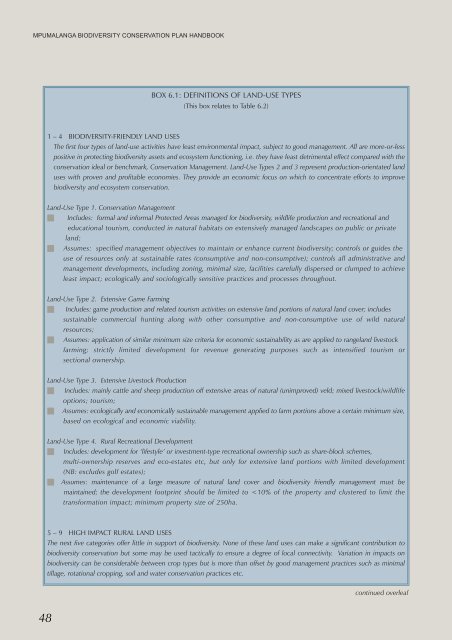Mpumalanga Biodiversity Conservation Plan Handbook - bgis-sanbi
Mpumalanga Biodiversity Conservation Plan Handbook - bgis-sanbi
Mpumalanga Biodiversity Conservation Plan Handbook - bgis-sanbi
You also want an ePaper? Increase the reach of your titles
YUMPU automatically turns print PDFs into web optimized ePapers that Google loves.
MPUMALANGA BIODIVERSITY CONSERVATION PLAN HANDBOOK<br />
48<br />
1 – 4 BIODIVERSITY-FRIENDLY LAND USES<br />
BOX 6.1: DEFINITIONS OF LAND-USE TYPES<br />
(This box relates to Table 6.2)<br />
The first four types of land-use activities have least environmental impact, subject to good management. All are more-or-less<br />
positive in protecting biodiversity assets and ecosystem functioning, i.e. they have least detrimental effect compared with the<br />
conservation ideal or benchmark, <strong>Conservation</strong> Management. Land-Use Types 2 and 3 represent production-orientated land<br />
uses with proven and profitable economies. They provide an economic focus on which to concentrate efforts to improve<br />
biodiversity and ecosystem conservation.<br />
Land-Use Type 1. <strong>Conservation</strong> Management<br />
Includes: formal and informal Protected Areas managed for biodiversity, wildlife production and recreational and<br />
educational tourism, conducted in natural habitats on extensively managed landscapes on public or private<br />
land;<br />
Assumes: specified management objectives to maintain or enhance current biodiversity; controls or guides the<br />
use of resources only at sustainable rates (consumptive and non-consumptive); controls all administrative and<br />
management developments, including zoning, minimal size, facilities carefully dispersed or clumped to achieve<br />
least impact; ecologically and sociologically sensitive practices and processes throughout.<br />
Land-Use Type 2. Extensive Game Farming<br />
Includes: game production and related tourism activities on extensive land portions of natural land cover; includes<br />
sustainable commercial hunting along with other consumptive and non-consumptive use of wild natural<br />
resources;<br />
Assumes: application of similar minimum size criteria for economic sustainability as are applied to rangeland livestock<br />
farming; strictly limited development for revenue generating purposes such as intensified tourism or<br />
sectional ownership.<br />
Land-Use Type 3. Extensive Livestock Production<br />
Includes: mainly cattle and sheep production off extensive areas of natural (unimproved) veld; mixed livestock/wildlife<br />
options; tourism;<br />
Assumes: ecologically and economically sustainable management applied to farm portions above a certain minimum size,<br />
based on ecological and economic viability.<br />
Land-Use Type 4. Rural Recreational Development<br />
Includes: development for ‘lifestyle’ or investment-type recreational ownership such as share-block schemes,<br />
multi-ownership reserves and eco-estates etc, but only for extensive land portions with limited development<br />
(NB: excludes golf estates);<br />
Assumes: maintenance of a large measure of natural land cover and biodiversity friendly management must be<br />
maintained; the development footprint should be limited to

















